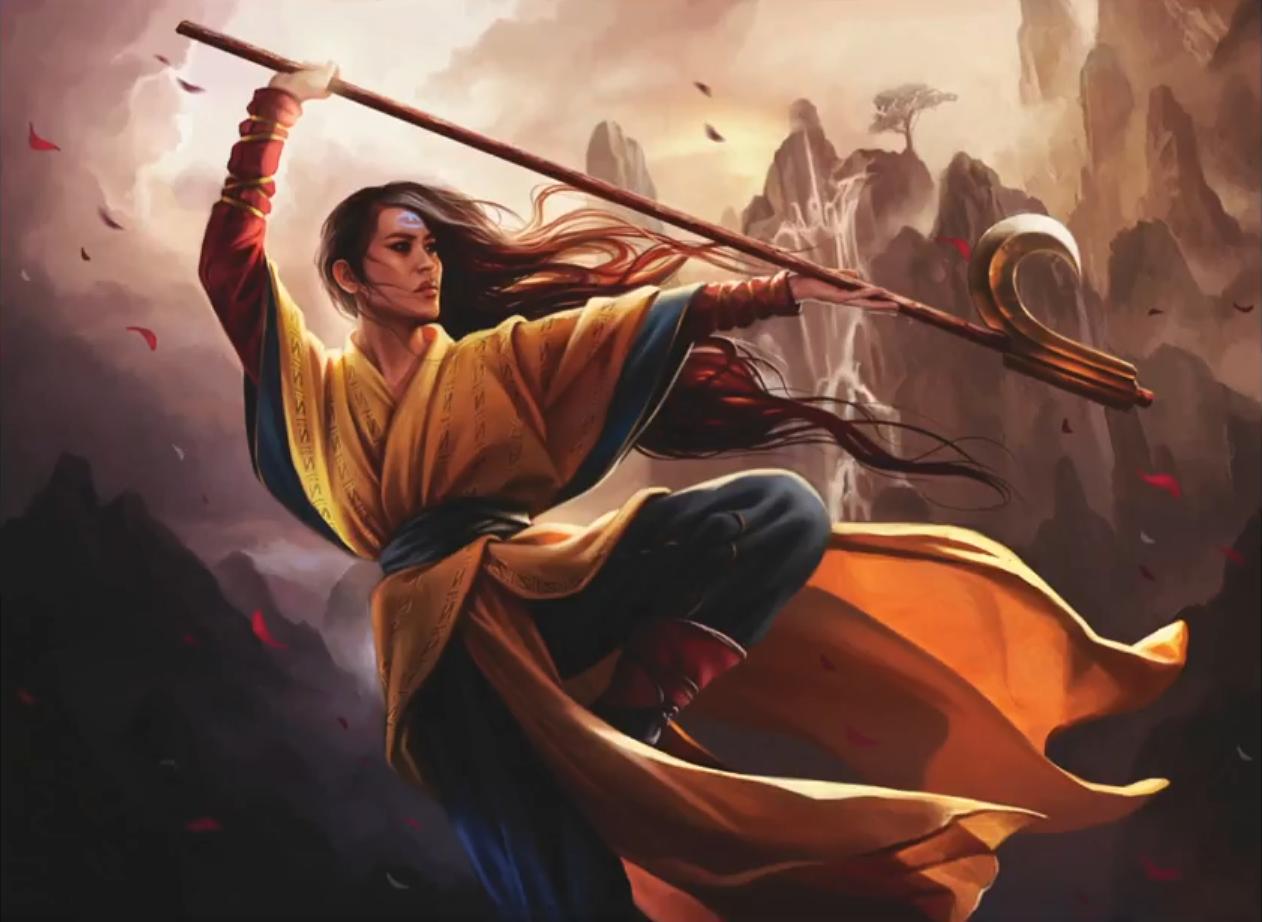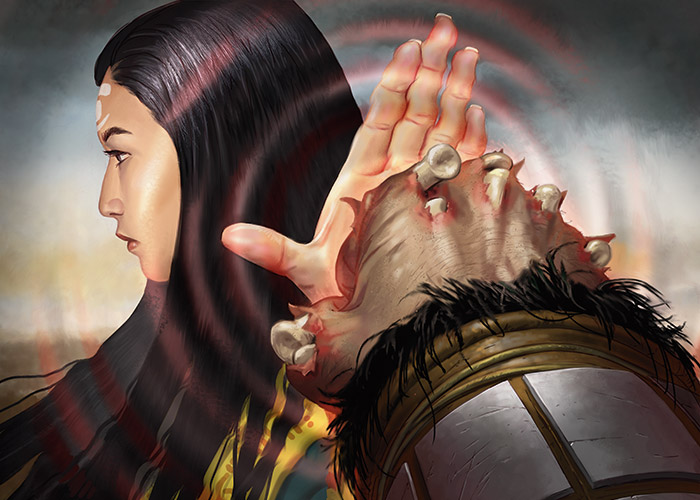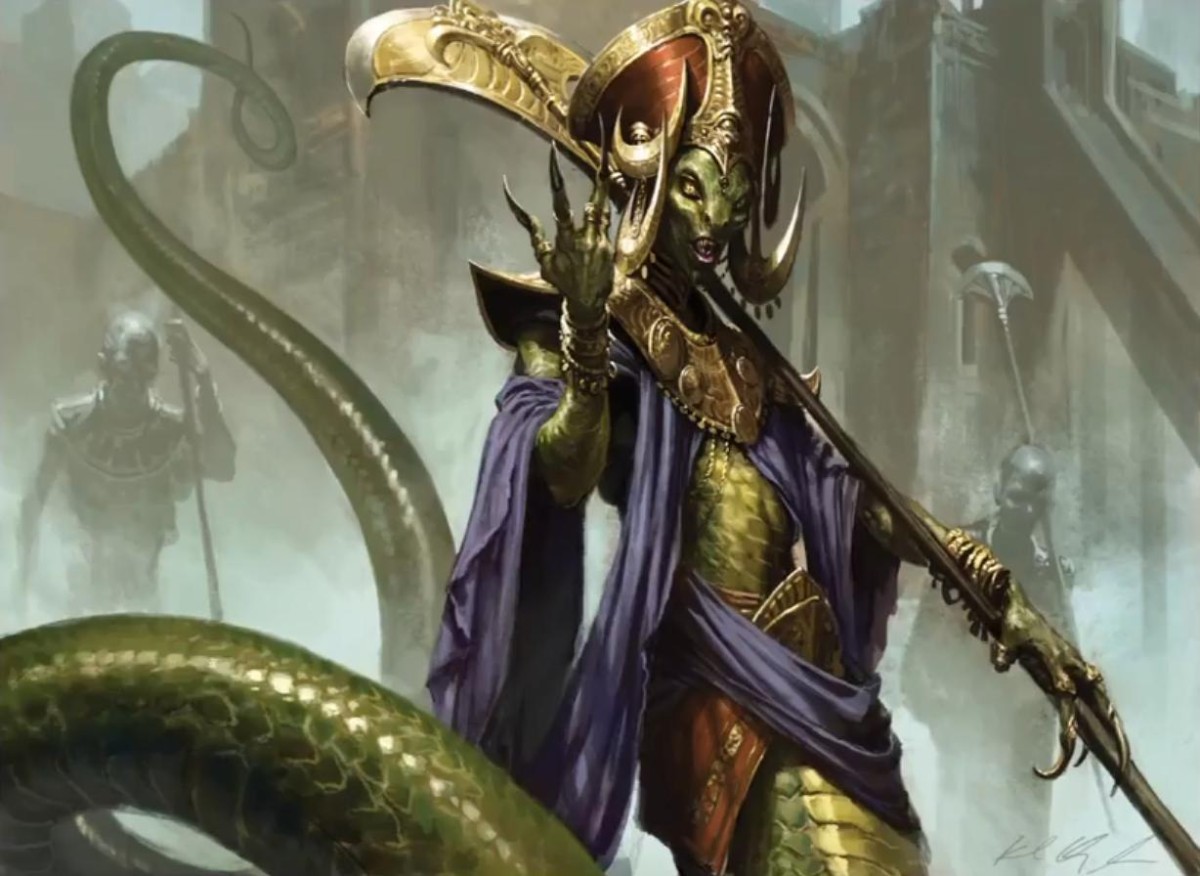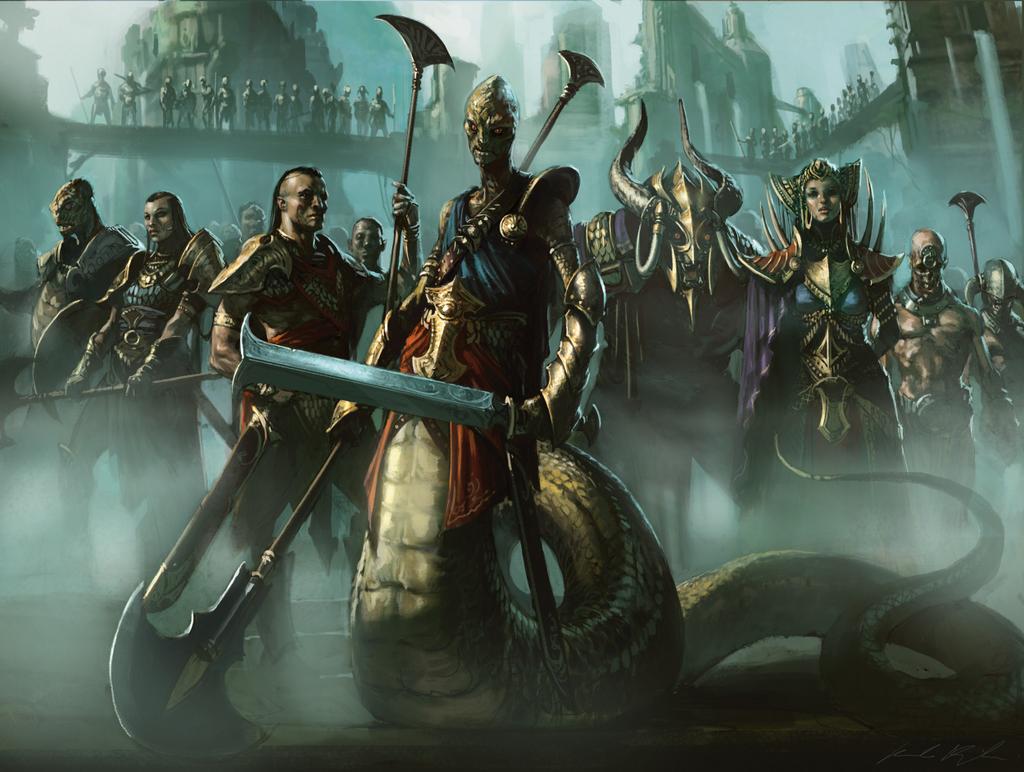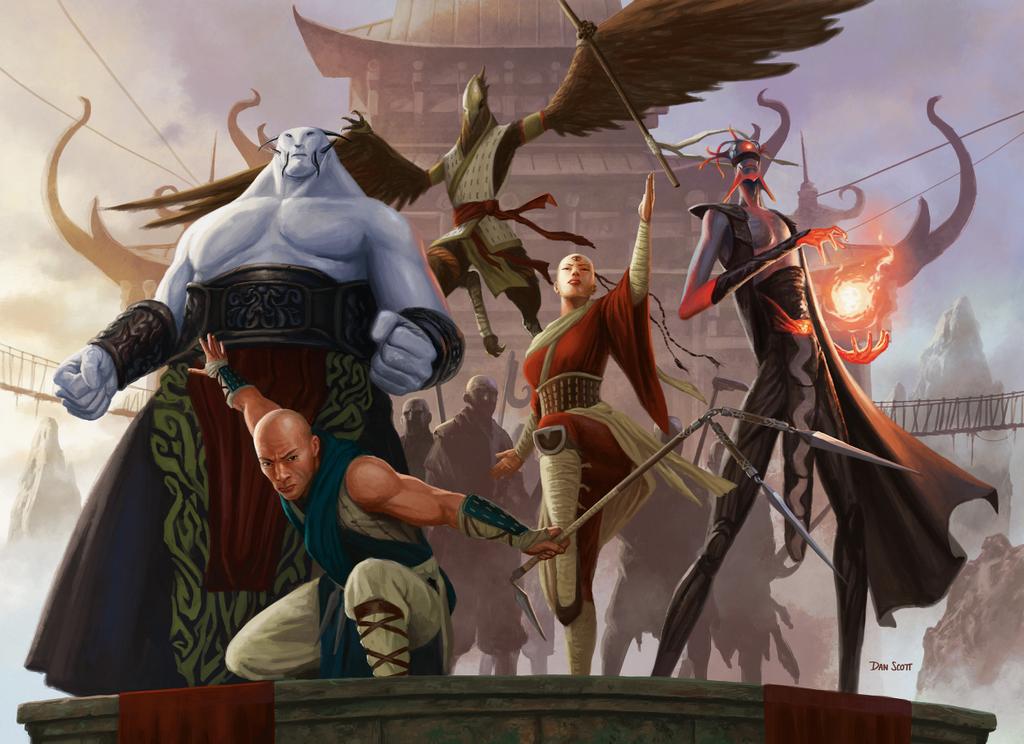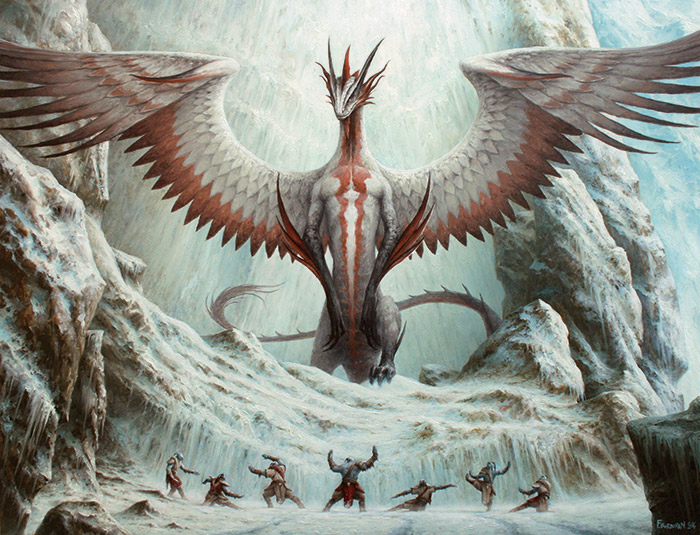Welcome back to Spells and Whistles! Two weeks ago we used Karla Ortiz’s fine work on [mtg_card]Liliana, Heretical Healer[/mtg_card] and [mtg_card]Liliana, Defiant Necromancer[/mtg_card] as a jumping off point for talking about Liliana as a character and her presentation throughout the years.
But time flies in the Multiverse! This week, previews for the upcoming Dragons of Tarkir set are in full swing, so we get to talk about Magic’s newest planeswalker, Narset!
Harry: Narset’s awakening as a planeswalker is one of the more anticipated character turns in recent years. She was introduced last fall in Khans of Tarkir as the khan of the Jeskai clan—a blue, white, and red-affiliated network of monks who study in mountaintop monasteries, seeking enlightenment through physical and mental discipline. In an Uncharted Realms story last fall, it was heavily hinted that Narset had the “spark”—the innate potential to become a planeswalker. However, in that version of Tarkir, Narset was killed by the Mardu khan [mtg_card]Zurgo Helmsmasher[/mtg_card].
Luckily, in Magic as much as other fantasy properties, death is often just a status ailment. In Narset’s case, Sarkhan Vol, the protagonist of the Tarkir storyline, rewrote Tarkir’s history by going back in time. Sarkhan’s intervention has produced an alternate present for Tarkir, one in which dragons once again teem in the skies and in which the characters we knew from Khans have different lives. It’s like the end of Back to the Future, when Marty McFly’s dad turns out to be really cool.
Christina: You’re welcome for showing you that movie, by the way. And I’m really excited for this new planeswalker.
H: Of course, that means we really have two versions of Narset to consider: the khan of the Jeskai, and the planeswalker from the new alterna-Tarkir. Let’s start with the khan, [mtg_card]Narset, Enlightened Master[/mtg_card]:
H: I’m a pretty big fan of this art. It’s relatively simple, especially in Narset’s unadorned clothing. But the pose—the staff, the raised knee, the wind in the robes and in Narset’s hair—generates some strong lines which move your eye across the picture. That’s counterbalanced by the serenity in Narset’s expression and the stillness of her body. It produces a contrast that’s fitting for the character and for the Jeskai philosophy more generally: the undeniable strength, contained within a calm exterior. Energy and grace. Power and humility.
C: The flowing lines are really evocative of motion here, not just of the wind (must it have what look like cherry blossoms in it? Maybe it’s an homage to anime, but still) but the motion of battle. I’m not sure how effective that weapon is—it seems likely to get stuck in or on someone—but it does create some nice harmony with the other curves of her flowing robes and hair.
As we’ll see in other images, Narset isn’t exactly balanced as we’d expect here—she’s actually tilted fairly far to the left. This isn’t a criticism, though. Practically speaking, it may be that the spearhead is very heavy, necessitating counterbalance. Artistically speaking, it implies that Narset is leaning into whatever wind is whipping at her, giving us a hint of her determination. It also creates an unexpected and somewhat unorthodox balance, not of symmetry, but of contrast: her open right side, her closed off left side—everything points (or aims) to the right of the image, but leans (and begins) on the left. There’s good flow, as you’d expect from Blue.
H: We get more of that calmness in other Khans art which features Narset, such as here on [mtg_card]Deflecting Palm[/mtg_card]:
H: Yeowch. The serenity pulls a lot of weight here: Narset’s expression doesn’t change at all, and in fact she’s barely paying attention to what she’s doing; she just stops the blow and breaks every bone in that guy’s hand in the process. Talk to the hand, Mardu dude.
C: Please be my friend, Narset.
H: There’s also the art from [mtg_card]Quiet Contemplation[/mtg_card]:
H: The water here is intended to evoke the eye, the symbol of the Jeskai clan. I’m also wondering if the tree here is specifically intended to be a reference to the Buddha. The stories and flavor text for the Jeskai regularly reference meditation and enlightenment, so Buddhism is certainly among their influences.
C: Possibly, but the Bodhi tree was supposed to be fig tree, and those looks like cherry blossoms. Maybe plum. Not that it’s important, it can still be Buddhist.
Narset’s upper body is in a somewhat meditative posture, aside from the asymmetry of her hands, but her legs are more active. It looks like someone trying to achieve balance but either isn’t there yet, or has a different balance than everyone else. Note the way that the entire image flows from the upper left to lower right, starting with the bright blossoms, through Narset reaching with her right hand and extending her left foot, and finally to the extra arcs of water. Then contrast with the waterfalls in the background, brightest in the upper right and darkest at the lower left. This entire image is a study in flow and contrast, but the effect is one of balance. Good job!
H: Chiastic structure, I think you mentioned. It’s an image that, fittingly enough, you are inclined to contemplate.
Still, this isn’t really the Narset we’re here to talk about. We’re really talking about Narset in the new Tarkir timeline, where she is alive and well—and also Magic’s newest planeswalker, Narset Transcendent:
C: Ah, speaking of balance, here it is again. This time it’s head-on, with Narset facing us directly. I really like the way her robes burst our around her flowing and swirling like water or wind. However, I do have a slight quibble about her posture: she looks a little wobbly. Her torso shouldn’t be at that angle, but rather straight-backed, or turned much more to the side. The slight tilt of her arms makes it look like she’s off balance, and not in a good, symbolic way. Still, her armor is cool (thank you, thank you, MTG, for skipping the boob plating!) and her expression striking.
H: I’m not sure I see the balance issue here, but I’m willing to forgive a little for a strong composition.
C: What’s with the fire, though? All the other art has shown her with water, and I don’t think this generates enough drama to really be worth the switch. Actually, the fires make the image look crowded and stifling, whereas all the others showed her in the freedom of the mountains and waterfalls. I wish we could see more of the statue she’s standing on, and less of this badly lit hall.
H: I think the setting could be symbolic here, actually, but we’ll get to that in a minute. My quibble here (and I agree about Narset’s general pose and facial expression) is that Narset’s attire seems overly elaborate to me.
I’m especially thrown by the upturned shoulder pads—originally I read them as a marker for Sultai fashion (the black-blue-green clan), as seen on art like [mtg_card]Dig Through Time[/mtg_card], [mtg_card]Sidisi, Brood Tyrant[/mtg_card], and [mtg_card]Sultai Ascendancy[/mtg_card].
H: In the former Tarkir, the Jeskai mostly wore simple robes, as you see in [mtg_card]Jeskai Ascendancy[/mtg_card] and [mtg_card]Flying Crane Technique[/mtg_card].
H: Definitely no peaked shoulder pads in that art. Again, the relative simplicity appeals to me here.
Looking through the Dragons art which has been spoiled so far, it looks like those shoulder pads are a new visual motif for the Ojutai clan:
You get a little of it here in Ojutai’s Command, especially from the woman on the left and the man in the middle right. (I love that haircut, by the way.)
It’s even more obvious in the art of this aven:
If I had to take a guess, I’d say that the new shoulderpads are a visual reflex of the dragon Ojutai, the leader of Narset’s clan: either the peaked pattern on his throat and chest, or maybe the way his wings look when he spreads them out:
So, not my favorite change, but one that we can make some sense of. If you are going to alter time, I suppose some costume changes are inevitable.
I’m also not the biggest fan of that whatever-it-is on the chestpiece of the mantle here, either—again, I think it’s a bit distracting. (I also can’t stop seeing a tiger’s face in there, which evokes the rakshasa—again, a Sultai thing.)
C: Eh, I don’t really see it.
H: So what do I like here? Well, I like the pose again. This one doesn’t create the strong impression of movement across the picture. Instead, the strong lines here are from the raised leg and the raised hands. They frame Narset’s body and face, so your focus gets pulled to the middle of the image and stays there.
I also like Narset’s face. Her eyes are transfixing, of course, but there’s also a lot of expression here: confidence, power, even a little curiosity (which is especially great for the character). Artist Magali Villeneuve posted some proofs on her Twitter account which really make me wish we could get more facial expressions into Magic’s postage-stamp sized art, somehow.
C: Yeah, maybe some kind of variant card with just her face would be cool.
H: And incidentally, I love that they gave Villeneuve multiple pieces of Narset art across the block. It really lets the character develop a distinctive visual style.
Of course, with Magic, there’s always more than just the card art. In Narset’s case, we have a story from this past week’s Uncharted Realms column, which describes Narset’s life on new-Tarkir before she awakened as a planeswalker.
There’s a lot to like here as well. It seems significant to me that it’s a story about a woman whose most significant aspect is her mind, who’s told to learn, to seek, to pursue knowledge. This happens at a young age—Narset ascends to the rank of Master under Ojutai’s tutelage at just fifteen.
Narset has especially strong logic and reasoning—a scientific or a mathematical mind, you might say—and these are traits which are all too frequently not praised in young girls: cue the old adage about how when we’re praising young children, we call boys “clever” and girls “pretty.” For a long time it was common to assume that women weren’t as good at these kinds of thinking, and we’re still dealing with those stereotypes. This is to say nothing of girls who live in places where they can be attacked or killed for trying to go to school.
C: Obviously I am in favor of a super smart lady planeswalker. I hope they let her give Jace a run for his money. Blue is so dominated by Jace that it gets a little tiresome. Also, a leading Asian lady! Who isn’t sexualized! It’s seriously awesome that her outfits are all so stylized without being either super form-fitting or super revealing. Sensible clothes for the sensible woman.
H: Of course, even for someone whose driving force is the pursuit of knowledge, it’s a bit strange to read about the ways Narset feels impelled to keep learning—literally and figuratively driven, to the point that she feels imprisoned when she has learned as much as she can about something. I didn’t pick up on it when I read the story the first time, but as it turns out, these aspects of Narset’s personality are a purposeful attempt to depict a character who is on the autism spectrum.
In the story, Narset’s ability to planeswalk becomes a very effective metaphor. It’s a way out of her home plane, but it’s also an invitation to the limitless knowledge of the multiverse—always more to see and explore. In that sense, it’s also way out from the claustrophobic feeling she has when she feels she can’t learn anything new.
I don’t know if they intended things this way, but the enclosed hall in Narset’s art could be read as a metaphor for this. She’s in a stifling space, as you say, but as a planeswalker, she has a way out of her prisons, both physical and psychical. You can see the power in her eyes—they’re blank, and therefore empty and unbounded.
C: It’s there subtly in the images too, I think: Narset’s balance and style are different from others. The way she moves isn’t wrong, though, it just creates different postures and compositions than we might otherwise expect. This element of the unexpected is, as with Alesha Who Smiles At Death, a positive. Good on Magic for this nice synchronicity of personality, power, and art.
H: And it points toward exciting things in store for how Wizards disseminates Magic’s story in the future. Doug Beyer has recently mentioned that Wizards is going to be trying new ways of bringing the story to the fans, which was reiterated in this weekend’s Magic panel at PAX East. It’s exciting to think about how upcoming sets could bring a lot more diversity, and not just of the kinds that are immediately discernible from the art itself.
That’s all for this week! Let us know what you think of Narset in the comments. We’ll be back soon with more of the art from Dragons of Tarkir.

